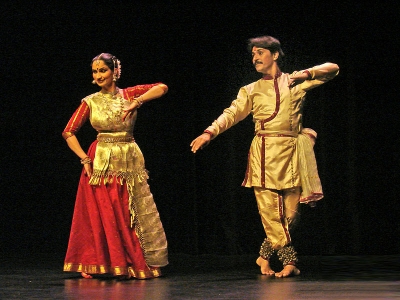
Kathak is undoubtedly the most popular classical dance style of northern India. The specialty of this dance is the spins and the circular movements that create a rare spectacle, the highlight is the rhythmic complexity and footwork that takes several years of devotion to master. Kathak has been acclaimed, for centuries, as one of the most distinct classical dance styles of India.
Kathak evolved from the Vedic period and with several evidences in the form of literature, paintings and sculptures, it is believed that Kathak originated from the story telling tradition. Incidentally, the word ‘Kathak’ has evolved from the word kathakaar (storyteller), hence varied stories from the Hindu mythology were narrated for spiritual and social uplift – “Katha kahe, So Kathak Kahalave” (Tells a story, hence known as Kathak).
The community of musicians and dancers were known as Kathakar. Buddhist and Jain literature also mentions the tradition of dancers in Vaishali, Magadh and Kosha. According to Valmiki’s Ramayana, Lava and Kusha, narrated the story of Ramayana to their father, Lord Rama, without realising that Rama is their father. Besides the storytelling aspect, other aspects like expressions, hand gestures and rhythmic footwork were added to attract theatrical appeal, as dance moved on from villages to courtyards, palaces and finally to modern-day auditoriums.
Kathak reached its pinnacle of glory as it attracted royal patronage during the Mughal regime. King Akbar married a Rajput princess and greatly encouraged arts and artistes. Performers from Persia and Central Asia were invited to perform, hence there was an inter mingling of cultures and styles.
While the Mughal dancers danced with the “salaami toda” and their typical styles, the Hindu dancers were different in their depiction and style of costume and “aharya abhinaya”. Nawab Wajid Ali Shah and Nawab Asaf Ud Daulah were great promoters and contributed their poetic renditions which were interpreted in expressional dancing.
As Kathak developed from different regions of north India, it maintained the regional differences and original poetic renditions; thereby different schools of Kathak evolved which were known as “Gharanas”. The Jaipur Gharana flourished with the Rajput patronage; one of the founders was Bhanuji, his descendants were Hari Prasad and Hanuman Prasad. The Gharana, further was promoted by Jailal and Sundar Prasad.
The Lucknow Gharana was founded by Thakur Prasad who was the Guru of poet Wajid Ali Shah, his sons were Bindadin and Kalka Prasad. The most popular Kathak maestro of contemporary society, Pt Birju Maharaj, also hails from the same family.
Janikiprasad Gharana also known as Banaras Gharana was founded by Sohanlal, Mohanlal, Naval Kishore and Kundanlal. Famous dancer Nataraj Gopikrishna belongs to the Banaras Gharana.
Music, training and performance
Both classical music, light and folk music have been adapted into Kathak dance according to regional differences and flavours. Bindadin Maharaj’s poetic renditions are used quite a lot, besides devotional rendering of Tulsidas, Surdas or Meera Bhajans.
Like other classical dance styles, it takes several years, for the student to get into the level of Visharad or Alankar. Continuous practice and complete devotion and involvement is necessary to become a fine exponent. The performance for one hour or more begins with a Vandana, prayer and invocation, followed with the execution of varied pure dance numbers with rhythmic complexity, tatkaar and finally a Tarana or an expressional Abhinaya number.
Some of the top Kathak dancers are Birju Maharaj, Shovana Narayan, Uma Sharma, Pt Pratap Pawar, Pt Nandkrishore Kapote, Pt Nagaraj, Paullomi Mukherjee and young dancers like Sunil Sunkara, Nidhaga Karunad and Jena Lakshmi.
Picture Credit : Google



